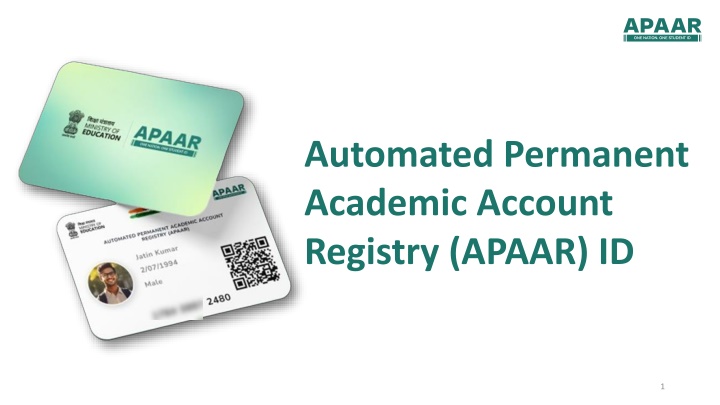
Revolutionizing Student Identification: APAAR System Overview
Explore the innovative Automated Permanent Academic Account Registry (APAAR) system, a specialized student identification solution in India. Designed to streamline educational processes, it offers digital integration, seamless transitions, and lifetime learning support. Learn about its evolution, registration process, and roll-out methods. Discover the significant impact of APAAR in education and student management.
Download Presentation

Please find below an Image/Link to download the presentation.
The content on the website is provided AS IS for your information and personal use only. It may not be sold, licensed, or shared on other websites without obtaining consent from the author. If you encounter any issues during the download, it is possible that the publisher has removed the file from their server.
You are allowed to download the files provided on this website for personal or commercial use, subject to the condition that they are used lawfully. All files are the property of their respective owners.
The content on the website is provided AS IS for your information and personal use only. It may not be sold, licensed, or shared on other websites without obtaining consent from the author.
E N D
Presentation Transcript
Automated Permanent Academic Account Registry (APAAR) ID 1
Introduction - APAAR APAAR, which stands for Automated Permanent Academic Account Registry, is a specialized identification system designed for all the studentsin India. It is a 12 digit ID consent-based ID , which stays with students throughout there educational journey. It is generated to maintain student records across academic lifecycle as envisaged under the NEP 2020. Digital Integration : All certificates , reports cards, and academic documents will be stored in Digi- locker, ensuring safety and accessibility, anytime anywhere. Seamless Transitions : Transfers across schools, states or districts will be hassle free. Lifetime Learning Support: Tracks students' progress and help in continuous learning and skill development Unified Tracking : It enables comprehensive monitoring of students educational journeys and tracking OoSC . Visualization of learning pathway through VSK: Integration of APAAR ID with the IT systems that are linked to VSK. Benefits 2
APAAR Evolution July 29, 2021 February 13, 2024 July 29, 2020 February 1, 2021 Hon'ble PM Modi launched NDEAR, a unified framework with principles, standards, guidelines, and policies to support digital education. Key NDEAR Feature Development of a studentregistry as a foundational block. Hon'ble Education Minister launched the APAAR ID during the National Conference on APAAR: One Nation One Student ID Card, a landmark step for unified student identification. Union Budget 2021-22 proposed the establishment of the National Digital Educational Architecture (NDEAR) to strengthen India's digital education ecosystem. Launch of the National Education Policy (NEP) 2020, with Para 24.4(b) emphasizing the development of a Digital Infrastructure for the Education Sector. 3
APAAR Registration Process for school students ID Creation Verification Parental Consent Authentication Upon successful verification, the APAAR ID is created and added to DigiLocker for secure online access Visit the school to verify demographic details Authenticate identity through the school Obtain parental consent if the student is a minor
APAAR Roll Out process APAAR Roll Out process Parent consent (Physical) collected in presence of school administration Session on APAAR benefits and long-term uses, Q&A session MEGA PTMs Called by School Activities during school PTM Verification of Consent Form with AADAAR Details School Login to UDISE+ Portal > APAAR Module APAAR ID created Stored to UDISE+ Activities of UDISE Coordinator after PTM Confirmation SMS delivered to parents UDISE+ registered mobile number School ID Cards to Print APAAR ID # INTEGRATED TO DIGILOCKER 5
Benefits of APAAR ID Tracking of dropouts Management of learning outcomes. Correlation of interventions with outcomes Data Driven decision making. Delivering ease of education in entrance test, admission etc. Management of academic and nonacademic records Targeted interventions Document management through Digilocker 6
APAAR Benefits for Students: Unified Academic identity: A single platform to consolidate and showcase academic records. Student ID Proof: It's an identity proof, which may have many other possible benefits as envisaged by schools, state government colleges & universities. Seamless Academic Mobility: Facilitating smooth transitions between educational levels. Lifelong Academic identity: Facilitate skilling reskilling upskilling from early school education to higher education and beyond during employment. Student Lifecycle Monitoring: Students can effortlessly monitor their academic journey, enabling personalized study plans and real-time performance analytics. Skill Gap Analysis: The system aids in skill gap analysis and provides industry relevant content for upskilling programs. Streamlining Student Academic Records: Simplifying academic record keeping for students.
APAAR Benefits for Parents: 1. Centralized Academic Record Management Stores a digital academic record of the child from school to higher education. Eliminates the need for physical certificates and documents for future admissions. 2. Hassle-Free School Transfers & Admissions Makes it easier to transfer students between schools without re-submitting documents. Ensures consistency in student records across schools and education boards. 3. Secure & Tamper-Proof Records Prevents loss or forgery of academic documents. Parents can verifyand access their child s educational records anytime.
Data Safety & Security in APAAR: Encryption Standards: APAAR employs advanced encryption standards to protect academic and personal data from unauthorized access. Compliance with Data Protection Laws: APAAR adheres to the India's data protection laws ensuring that all collected information is handled according to legal requirements, in compliance to NDEAR, DEPA. Access Control: Only authorized personnel have access to the data, and multiple layers of security ensures that this access is monitored and restricted based on roles. Audit Trails: Regular audits and logs are maintained to track who has accessed the data and how it is being used, ensuring accountability.
APAAR Generation (Management and Class Category wise) as of 16th Mar 2025 Middle (Classes VI - VIII) Secondary II (Classes XI & XII) Higher- Secondary Foundational & Preparatory (Balvatika - II & Classes III - V) Secondary I (Classes IX & X) Categories Total Pre-Primary Primary Upper-Primary Secondary Enrolment 24,73,58,456 1,30,55,375 10,76,99,336 6,30,32,295 3,68,07,643 2,67,63,807 APAAR Generated 13,46,50,283 54,35,257 5,92,25,291 3,66,34,653 1,95,46,489 1,38,08,593 Generation % 54% 42% 55% 58% 53% 52% Government Aided Management Total Government Private Other Enrolment 24,73,58,456 12,70,74,968 2,54,98,864 8,98,36,157 49,48,467 APAAR Generated 13,46,50,283 7,05,46,353 1,47,74,575 4,81,09,773 12,19,582 Generation % 54% 56% 58% 54% 25% 11
Information resources for APAAR Resource Access: For detailed information and resources, visit https://apaar.education.gov.in/. The site includes FAQs and a step-by- step guide to the APAAR ID creation process. Multi-lingual Materials: Schools are encouraged to utilize multi-lingual materials to facilitate communication and understanding of the APAAR initiative among diverse populations. Raise Any Query : APAAR Helpline Number: 1800-889-3511


